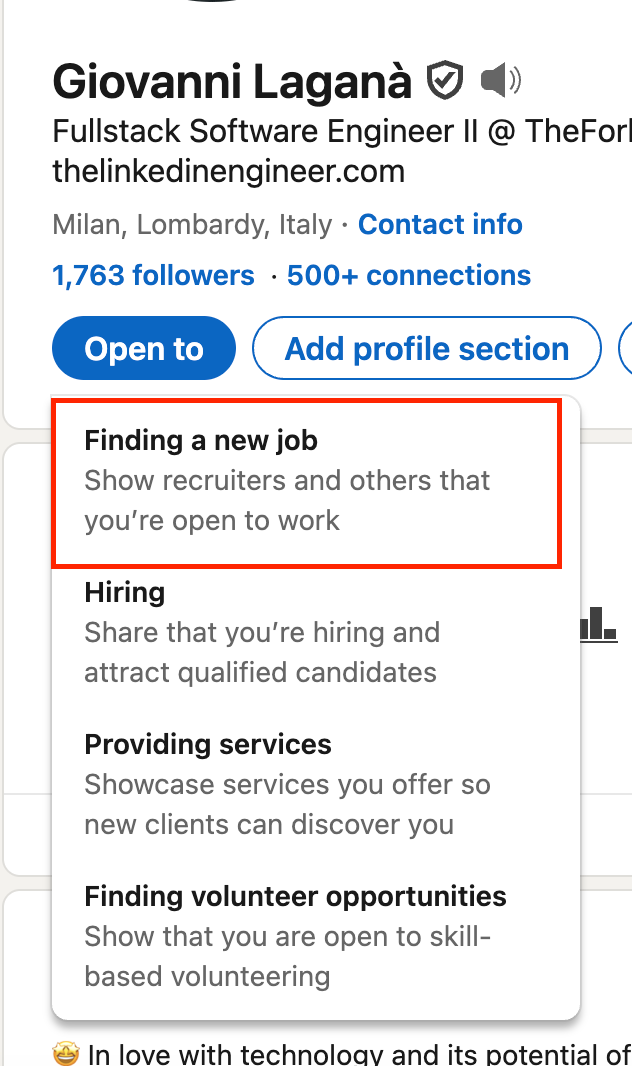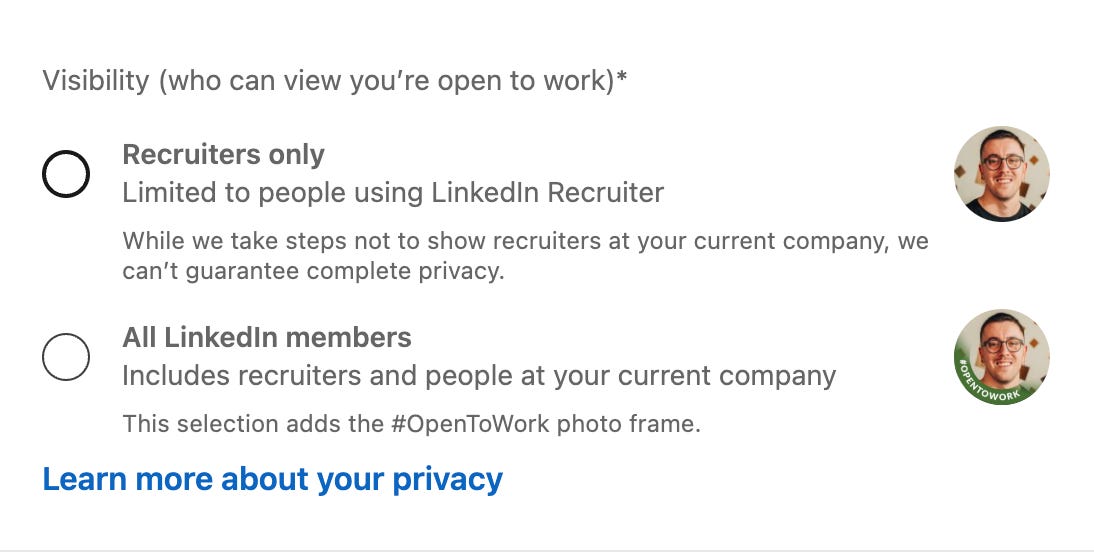Open to work: Yes or No?
Let's answer this hot topic 🔥
“Open to work”.
Such a simple sentence, and yet able to create tons of discussions.
I’m talking about probably the most controversial feature on LinkedIn — the one that divides users, the one you either love or hate.
Today, I’d like to give you my take on this hot topic, and try to come out of it alive 😂
First of all, we can’t say that LinkedIn doesn’t push for its usage, since it’s accessible directly by clicking the “Open to” button — the very first one on your profile.
Here, you can specify what you’re currently up for, which can also include hiring, providing services, or finding volunteer opportunities… but today we’ll focus on the most famous variant: the one where you declare that you're open to finding a new job.
Reflect on your condition 🫵🏻
LinkedIn has 1.2B users (as of January 2025), and it’s supposed to support all possible work sectors with the same features.
As you know, each industry has its own demand and offer. Depending on who you are and what your profession is, you might be more or less attracted to this feature.
Your sector
I’m assuming I’m talking to someone working in the software industry, and for this reason, I’d like to reflect on the current demand for software engineers worldwide.
According to this source, in 2024 the global demand for SWEs has grown by +17%. And despite all the pessimism you might have heard around the impact of AI, software engineering is still one of the fastest-growing sectors. Becoming a developer is still considered one of the most profitable careers.
Even considering AI itself — software built around AI or integrating it might become one of the most requested skills in the coming years. This shouldn’t represent a threat for an engineer, but rather another opportunity.
Your employment
Are you a student? Are you employed? Are you on a career break?
Depending on that, we can do some reasoning:
if you are a student, your status naturally puts you in a condition where you’re already open to work (unless you’re studying just for personal satisfaction).
if you are employed, you probably want to avoid your company knowing you’re looking for other opportunities.
if you are on a career break, it might get interesting to put the “Open to work” badge, especially if you are quite popular, like MR.Rip, and you have built your personal brand around the idea of being “Unemployable”. If, for some reason, you have decided to change this and want to communicate it to the world, the badge can help.
Your expertise
Depending on what’s your level of seniority, you might be more or less “rare” for the market, especially if we combine this with the technological stack you can work on, or the areas where you might have built expertise.
Your (ex) companies
The prestige of the companies you’ve worked for in the past, or the one you currently work for, is another factor that increases recruiter interest when searching for candidates.
Your (expressed) talent
How talented you genuinely are is not a detail. However, how visible and recognizable that talent is still depends on you — and on the effort you put into showcasing the impact you have in the world thanks to it. Keeping your talent a secret won’t help you on LinkedIn.
How appealing are you? 😋
Now, you should have all the tools to evaluate how appealing you are to a recruiter:
your are likely a Software Engineer, either a student or a professional with X years of experience, and you can give yourself an honest opinion of how prestigious the companies you worked for were, and probably you can also have an idea of how performant you have been so far.
Considering the high risk of biases in this introspection, let me tell you something:
Just working in this field already puts you in high demand. On average, you can easily say that your professional position is better than that of probably 80% of the population.
The questions above probably help you understand instead if you can position yourself among the top 5% of engineers that are going to be working in the best companies.
Let’s talk about Negotiation 🤝
I am fairly confident that, once you stepped into professional world, you quickly discovered the importance of being able to negotiate.
Negotiating your salary, your benefits, your working policy, etc.
In general, when you start having interviews, you soon realize that what’s happening under the hood is a mutual interest check where both parties observe each other, keeping some parts hidden, and some other exposed.
This is done carefully in order to approach each other step by step and understand whether there can be a match.
But it doesn’t stop there. Some things are intentionally kept secret to avoid being too exposed, and to gain an advantage during negotiations.
This is exactly what happens when you negotiate salary: the first one to mention a number automatically sets a baseline, and not revealing it helps you gaining the little advantage of not underestimating this baseline.
The idea is that you typically want to understand first how much the other party is willing to pay, and then only afterwards reveal how much you’d like.
Now, according to you, who is going to pay more for you:
a company that knows you are already searching for a job, or a company that wants to convince you even if you are not looking for an opportunity?
Are you aiming for Quantity or Quality? 😜
Enabling this option might increase the chances that recruiters write you. Especially those urgently looking to fill a position. Is this something you need?
If you think about it, I am basically asking you the same question in different ways:
how urgently do you need a job?
Nothing more, nothing less, this is the core aspect you should consider. Based on your answer, you might lean toward quantity (if you are struggling to get a job), or toward quality (if you are lucky enough to be already consistently receiving interview proposals).
What’s the relationship with your current company? 🙄
Do you care if someone from your company sees that you are actively searching for a new job?
It’s true, if you opt for this badge, you can choose to show it only to people using LinkedIn Recruiter. But even LinkedIn says they can’t guarantee full privacy (also reiterated here), and honestly, nothing prevents recruiters from using other strategies, like using different accounts not linked to the company.
Considering their network, it’s not rare for them to find out anyway.
Let’s recap ✍🏻
To sum up, here are the pros and cons of the “Open to work” badge:
Pros ✅
Increases chances of being contacted
Clearly communicates your intent to find a job
Cons ❌
Loss of negotiation power
Risk of being discovered by your company
Lower quality offers (companies in a hurry)
Associated with people who are struggling to find a job
Final Takeaways 🔚
Unless you are in a particular situation where you need to come out from a difficult moment, and cons don’t represent a problem for you, I recommend you to not use the Open to work badge.
As a Software Engineer, your position is already privileged in most cases, and by default, you can afford not to use this feature.
In general, I believe your ultimate goal on LinkedIn should be to stand out.
And to stand out, the secret is not to take a shortcut and press a magic button.
The point is to make your profile speak for you.




